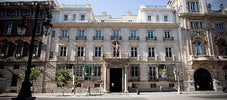
The Royal Academy of Fine Arts of San Fernando and its relevance to contemporary Spanish art
, 4 min reading time

, 4 min reading time
As we all know, in Spain we are lucky to have a very rich cultural heritage. Our contemporary art history of the last century has left us a legacy with some of the most important artists of their generation and with them, we can say that some of the most important works in art history were born in our culture. Pablo Picasso, Joan Miró and Salvador Dalí are, without doubt, the most international benchmarks of this period.
Some of these artists got their training at the Royal Academy of Fine Arts of San Fernando. Here we review some of the most important historical moments of this academy.
It opened in 1752 during the reign of Ferdinand VI in order to change the way of teaching that the visual arts had so far. With the creation of this academy, the training received by the students would be more accessible and would leave aside the learning at workshop. At the beginning, it was regulated the teaching for painting, sculpture, architecture and engraving. Just over a century later, music would join these disciplines. The reform of 1987 incorporated television, photography, video and film sections.
Although the school was opened by three Italian artists, now it has 56 academicians of number. These personalities are honoured to have this title for having recognized prestige in their field.
This school has had many important artists learning in its rooms, but perhaps one of the most controversial one would be a young Dalí that attended his studies by the early 20s. During his school years he met with other future stars of contemporary Spanish painters such as Benjamin Palencia, Rafael Zabaleta and Julio Romero de Torres. His most important college would probably be painter Maruja Mallo, with whom he struck up a great friendship. Dalí, this colourful character with long hair and sideburns would establish more relationship with his fellow mates at the Students Residence in Madrid, the poet García Lorca and filmmaker Luis Buñuel were among them. We refer to a controversial Salvador Dalí because he was expelled from the academy twice. The first time was in 1923 for leading a student protest against not granting the chair to the painter Daniel Vázquez Díaz. In 1924 he resumed his studies repeating year, but just prior to his final exams in 1926, Dalí would definitely be expelled from the academy by declaring that there was no academic teacher with enough skills able to examine his work.
Benjamín Palencia, along with sculptor Alberto, founded the "Escuela de Vallecas", joined by some of his fellow students as well as other cultural figures of the time as Rafael Alberti or Pablo Neruda. Years later, some other artists would go through the academy and be part of the "Second School of Vallecas" such as Menchu Gal or Luis García-Ochoa.
The famous group "El Paso" wouldn’t have been the same if some of its members had not studied at the Royal Academy of Fine Arts of San Fernando. Luis Feito, Juana Francés and Martín Chirino studied together at the center and joined other artists such as Antonio Saura, Manolo Millares and Rafael Canogar to create this group that had such a relevance in Madrid’s art scene.
The realist painter Antonio Lopez and Lucio Muñoz, both belonging to the known as "Madrid school" also attended their studies of fine arts at the academy. Some years later Darío Villalba also would step in the classrooms of the center.
At the present many of these artists just mentioned are academics in the institution, some being more involved than others in the tasks developments corresponding to the management of the Royal Academy. But as we also mentioned earlier, academics are entitled based on their recognition and therefore not all of them have passed through the academy classrooms. Thus, in the honor table of recent years we can find artists of the stature of Joan Hernández-Pijuan, Martin Chirino, Antoni Tapies or Gustavo Torner . Currently Rafael Canogar, Luis Feito or Antonio Lopez are some of these academic figures.
Please, don’t hesitate visiting the academy’s website for more info at: Real Academia de Bellas Artes de San Fernando (only in Spanish).
Be the first to know about new products and offers!